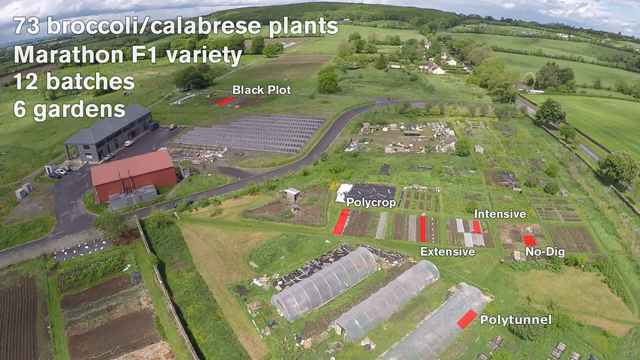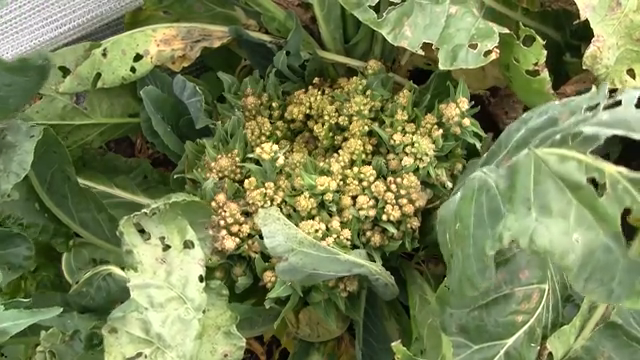This season I've grown really good broccoli.
Or more accurately really good Calabrese, which is a particular variety of broccoli that reduces the really big heads that we usually find in the shops.
A few of the heads they tasted were really delicious, and a lot of other people agreed.
I hadn't realized the broccoli could taste so good.
In the past, a good head of broccoli occasionally came out of my Gardens, but it was rare enough.
No doubt this had something to do with the fact that I wasn't so fond of broccoli, I saw it as a finicky and overrated vegetable.
But now I'm a big fan, because the crop this year was so good and so delicious.
The question is, why have I been more successful with broccoli this year than in other seasons?
The good weather we've had is part of the answer.
I think a more substantial part, is that I have finally managed to do all the things that I needed to do, when they needed to be done.
I selected a suitable variety of broccoli for the climate I'm growing in.
I bought fresh, strong seed from a reputable source.
I used a good growing medium, or compost, with enough fertility for the young plant.
I used an appropriate sized container or block.
I sowed the seed at the right time of year so that it was warm enough for good germination and fast growth of the seedling.
I carefully water to ensure the growing medium stayed moist but not wet.
I thinned the seedling to one plant per pot or block.
I chose the part of the garden that didn't have brassicas growing in it for the past few years to reduce the chance of soil borne disease.
I prepared the final growing beds well in advance so that it was ready for transplant.
I added plenty of fertility to the soil.
I gradually hardened off the seedlings before transplanting.
I waited for calm, overcast day for transplanting in order to reduce stress in the plant.
I transplanted the seedlings before they got to root bound.
I carefully transplanted the plants into the growing bed, and watered them in.
I gave each plant enough space to grow to the desired size.
I protected the young seedlings from slugs and snails.
I protected them from flea beetles.
I protected them from cabbage root maggots.
I protected the young plants from birds, chickens, and other animals.
I prevented the beautiful white butterflies from laying eggs on the plants to avoid caterpillars.
I removed any caterpillars that did hatch, to avoid leak damage and I really didn't want them inside the heads of broccoli.
I watched out for a range of other diseases and deficiencies.
I continued to weed around the plants to reduce competition.
I watered the plants when necessary, especially during the dry weather early in the season.
I provided additional feeding to the plants later in the season.
I kept an eye on the plants so that I could harvest a large central head at the right time.
I then left the plants in place for a few more weeks so that I could continue to harvest aside shoots when they were ready.
Failing to do any of these things could be the difference between a great crop and a poor crop.
Some of them, like letting the seedlings dry completely or failing to protect from slugs and caterpillars could lead to a complete failure.
But you can get away with a lot of things, because plants really want to grow.
A reasonable crop is possible if you don't follow everything on this list, but an excellent crop seems to rely on doing all of them, and probably more.
Most of the tasks on this list are relatively easy to do.
But, consistency is issue here, doing what needs to be done at the appropriate time.
Weather of course is a big unknown factor that can be really hard to prepare for, especially with this shifting and erratic climate.
But high winds can be covered with wind breaks, prop covers can help moderate low temperatures, dry conditions can be managed with extra watering, and heat waves, well, thankfully they're not really an issue in Ireland yet.
So there are always things you can do to moderate the worst weather that each season can bring, if you are willing to put in the extra effort.
Overall, this year has been a good season for growing broccoli, as they do well and grow quickly with the moderate temperatures and consistent moisture we have had.
This fast growth makes many of the other issues less problematic.
Another way of looking at this is that poor weather, excessive heat, cold temperatures, waterlogged soils or dry soils, or high winds can exacerbate the things that I haven't done well.
For example failing to keep the crop weed free is more of an issue in extended dry spells.
Or the slow growth during cold weather can enable the slugs that I haven't dealt with to really damage a crop early in the season.
Although it was a good crop this year, not everything I planted produced well.
In total I grew 73 plants of one variety of Calabrese or broccoli, in 12 batches, spread across six gardens with their different soil treatments and growing methods.
Out of the 73 plants I harvested 46 really good heads of broccoli, some of them were exceptional.
But, what happened to the rest of them? slugs damaged 11 of them, either eating the head or seriously damaging the younger plant, including killing off five of the plants in the No-Dig garden.
6 suffered from the heat of the polytunnel and produced a smaller crop.
Another 6 failed to produce well because of too much competition within the Polycrop garden.
I harvested 2 heads a bit late and they had started to loosen up and become less tender.
And I'm not sure why two of them were so small - perhaps they suffered from transplant shock.
While it is great to be able to produce so many really good heads of broccoli, I have some work to do to get closer to 100% success rate.
I also wonder how much better even the good ones can get, what factors can be improved.
Have I tasted the best broccoli I will ever taste, or is there more room in the scale? is what I now consider to be exceptional, merely just good?
I'm not sure what happened with issues cauliflower crops though.
As there are very similar plants to broccoli, though perhaps a bit more demanding, they should respond well to the same good conditions and treatment.
Last year was more successful, but this year I've only been able to produce a few reasonable heads of cauliflower.
Most of them fail to produce the dense why curds of this vegetable is famous for.
It is possible that the variety I grew this year isn't really appropriate for my conditions.
Or that the seed wasn't good enough.
Or maybe some other factor that caused stress in the plants.
I don't really know.
I plan to conduct variety trials next year, for both cauliflower and broccoli, growing a number of different varieties side by side, to determine which ones are more successful, or more suitable to my gardens.
Thankfully I have the space in the black plot to do this kind of exploration.
The other tasks are to continue to refine the methods that are used to grow these crops, and to consistently do all the things that need to be done.
I'm looking forward to growing a really good crop of cauliflower, and to seeing how much better broccoli can get.
I've known for quite a while that I needed to do all these things to grow really good crop of broccoli.
I read about it all in books years ago.
But has taken me quite a while to consistently, finally do all the things that I knew needed to be done.
I believe this is the difference between knowledge and skill.
I had the knowledge, but I needed to develop the skill in order to adequately and consistently apply that knowledge.





